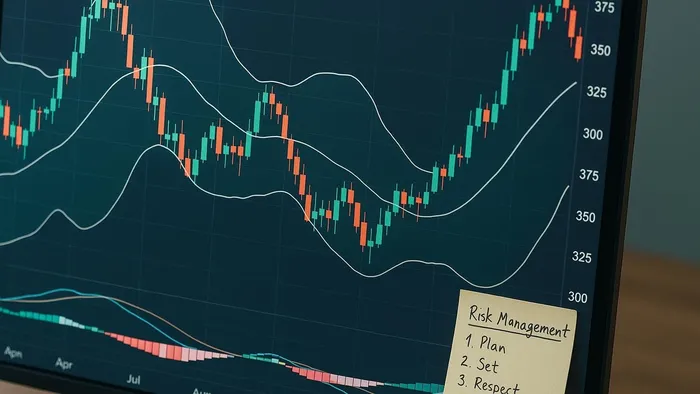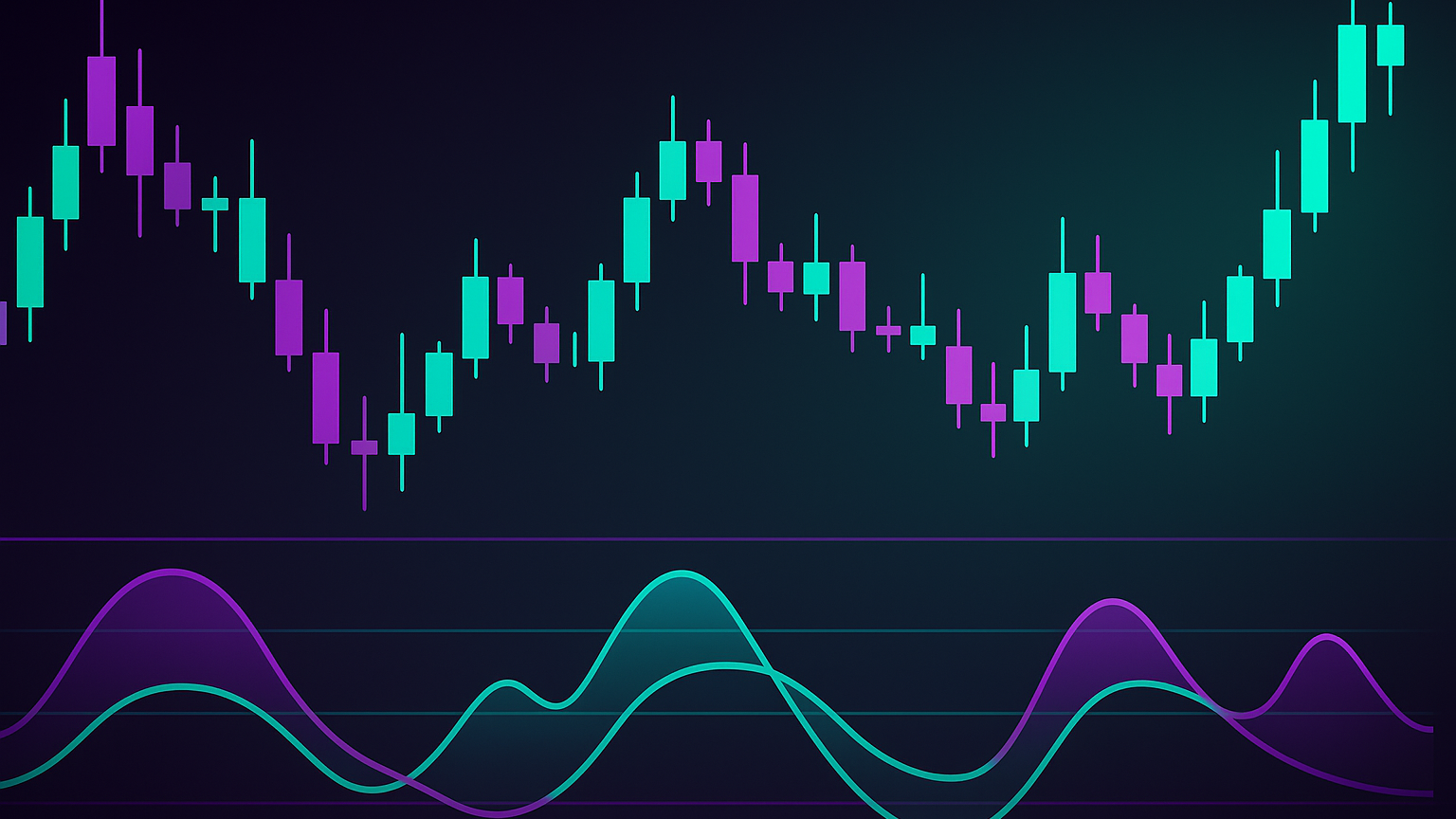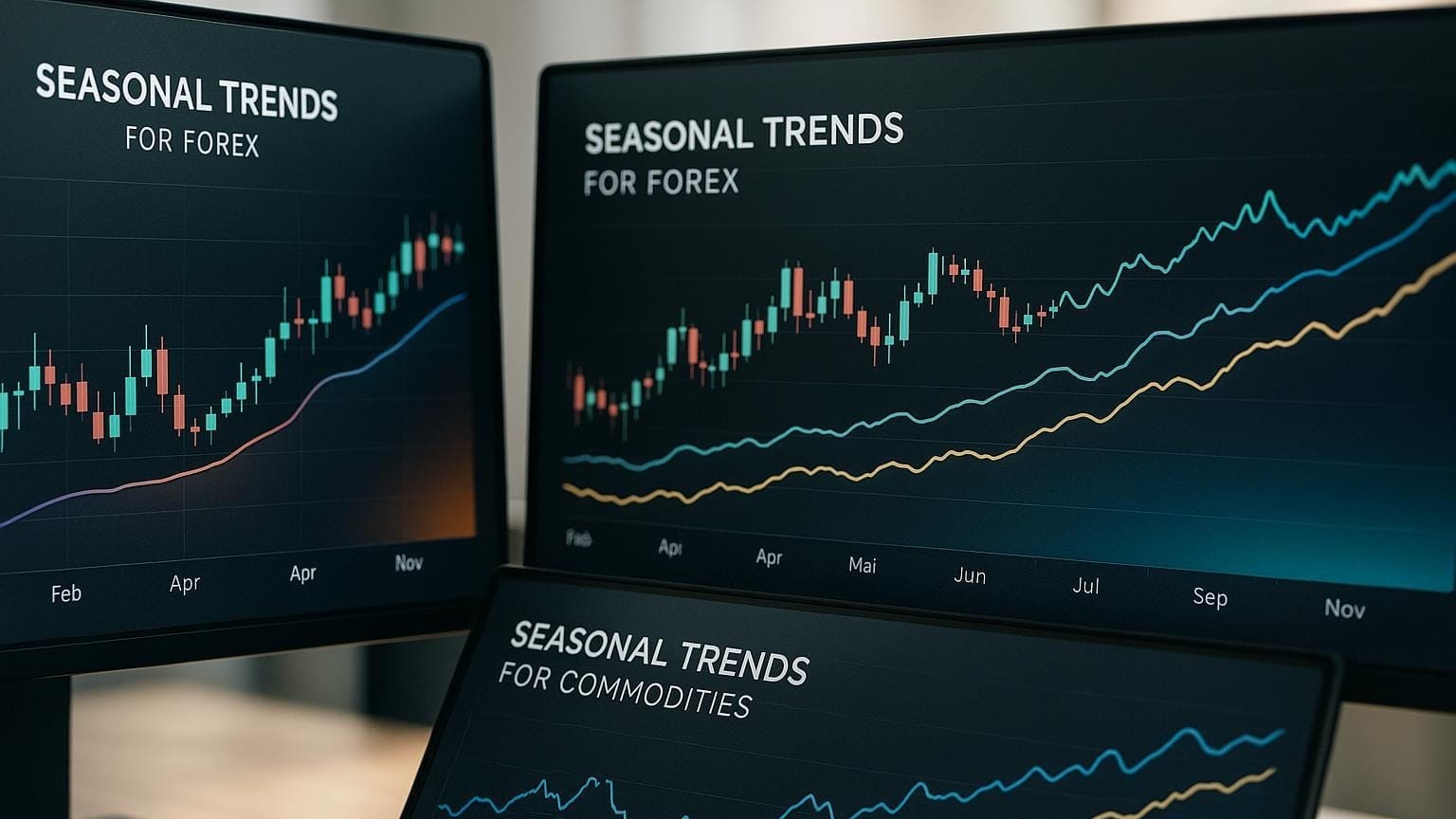Learn how to implement mean reversion trading strategies effectively using key indicators, risk management, and advanced tools for better decision-making.
Mean reversion trading is about spotting when prices move too far from their average and are likely to bounce back. This approach can work well in volatile, range-bound markets, though actual win rates depend on the asset and settings used. Here's what you'll learn:
- Key Indicators: Use tools like Bollinger Bands, RSI, and volume analysis to identify overbought or oversold conditions.
- Entry/Exit Rules: Enter trades when prices hit extremes (e.g., outside Bollinger Bands) and exit as they return to the mean. See Bollinger Bands entry tactics for context.
- Risk Management: Limit risk to 1–2% per trade, use stop losses, and adjust for volatility. ATR-based stops can help.
- Tools: LuxAlgo provides TradingView indicators like Oscillator Matrix and Price Action Concepts to refine your strategy with multi-timeframe analysis and AI Backtesting.
| Trading Style | Win Rate | Holding Period | Best Market |
|---|---|---|---|
| Mean Reversion | Often high in ranges* | 2–10 days | Volatile/Range-bound |
| Trend Following | Lower but larger R multiples | Extended | Trending |
*Backtested results vary by asset, timeframe, and parameters.
This strategy is ideal for traders seeking consistent, shorter-term profits by capitalizing on price extremes. Dive in to learn the step-by-step process! For a deeper guide, see Mean Reversion Playbook.
10 Mean Reversion Trading Strategies
Finding Price Extremes
This section delves into identifying price extremes using technical setups. By combining indicators and volume analysis, traders can spot these opportunities and determine safer entry points to counteract extreme price moves. If you’re new to the concept, our mean reversion primer walks through examples.
Bollinger Bands Setup
Bollinger Bands are a visual tool that highlights extreme price movements. Here’s how they work:
- A 20-period simple moving average forms the basis.
- Upper and lower bands are set at two standard deviations from the moving average.
- The bands adjust automatically based on market volatility. For variations, see band indicators explained.
| Market Condition | Band Position | Trading Signal |
|---|---|---|
| Overbought | Price touching the upper band | Potential short entry |
| Oversold | Price touching the lower band | Potential long entry |
| Normal Range | Price between the bands | No clear signal |
“Bollinger Bands is a technical analysis tool used to determine where prices are high and low relative to each other.” — Investopedia
Since the bands encapsulate about 95% of price movements within two standard deviations, any move outside these bands is statistically noteworthy. If you want Bollinger-specific signal readouts, consider the Bollinger Bands Breakout Oscillator.
RSI Signal Analysis
To complement Bollinger Bands, the Relative Strength Index (RSI) adds numerical confirmation of overbought and oversold conditions. For advanced thresholds and divergence use, see our RSI upgrade guide and Ultimate RSI indicator.
- Overbought: RSI above 70 signals potential selling pressure.
- Oversold: RSI below 30 indicates possible buying opportunities.
- Trend Context: In an uptrend, RSI usually stays between 40 and 70, while in a downtrend, it often remains below 60.
Volume Analysis
Volume analysis plays a critical role in confirming reversals during extreme price moves. Here’s what to watch for. For automated S/R context, check Support & Resistance Dynamic and Oscillator Matrix docs on money-flow trends.
- Volume Spikes: A sudden increase in trading volume during extreme moves often signals market exhaustion.
- Volume Trend: Declining volume during a price move suggests weakening momentum.
- Level Analysis: Volume at key levels, such as previous highs or lows, provides additional context for potential reversals.
When price touches the upper Bollinger Band, RSI exceeds 70, and volume spikes, the case for a short entry becomes stronger. Conversely, when price hits the lower band, RSI drops below 30, and volume surges, it supports a long entry.
Mean Reversion Strategy Steps
Mean reversion trading relies on a structured approach to entering and exiting trades, along with disciplined risk management. By combining technical indicators with volume analysis, these steps help turn theoretical strategies into practical trading decisions. If you prefer an algorithmic workflow, see algorithmic mean reversion.
Entry Rules
Before entering a trade, confirm signals from multiple conditions:
| Condition Type | Long Entry Signal | Short Entry Signal |
|---|---|---|
| Price Location | Below the lower Bollinger Band | Above the upper Bollinger Band |
| RSI Reading | Below 30 | Above 70 |
| Volume Confirmation | At least 50% above average daily volume | At least 50% above average daily volume |
| Standard Deviation | Between −2 and −3 SD from the mean | Between +2 and +3 SD from the mean |
Once these criteria are met, you can enter a trade. But the key to success lies in knowing when to exit. If you want to script and test these conditions, AI Backtesting lets you rapidly iterate on entries, exits, and filters.
Exit Methods
Profits are often realized when prices revert to the moving average or fall within 1–1.5 standard deviations of it. This locks in gains while avoiding unnecessary risks. For a practical walk-through, see scale-out exit techniques.
“When trading a mean reversion trading strategy, profits are made in range-bound markets with profit targets relatively close to trade entries. Therefore, implementing robust risk management is crucial.” — Janne Muta
Risk Controls
Effective risk management is the backbone of successful trading. Here’s how to protect your capital:
-
Position Sizing
Limit risk to 1–2% per trade. Use this formula to determine position size:
Position Size = Risk Amount ÷ Distance to Stop Loss
For deeper context, review our notes on position sizing. -
Stop Loss Placement
Set initial stop losses based on market volatility:- Normal volatility: 1.5 × ATR (Average True Range)
- High volatility: 2 × ATR
-
Adjusting for Volatility
During volatile markets:- Reduce position sizes by 25–50%
- Widen stop-loss distances to accommodate larger price swings
“The secret to trading is to lose the least amount possible when you're wrong.” — Paul Tudor Jones
LuxAlgo Tools for Mean Reversion

LuxAlgo provides TradingView indicators and AI that help refine and strengthen mean reversion trading strategies. By combining advanced technical analysis with AI-driven insights, the goal is to improve precision and decision-making. Here’s how each product area supports a mean reversion approach.
LuxAlgo Oscillator Matrix
Oscillator Matrix helps detect divergence in real time across multiple timeframes. It can pinpoint potential reversal points by analyzing overbought and oversold conditions through multiple oscillators. Learn setup basics in the Oscillator Matrix docs.
| Timeframe | Divergence Signals | Trading Application |
|---|---|---|
| Primary (H4) | Bullish/Bearish RSI | Confirms entries |
| Secondary (H1) | Money-flow trends | Validates volume |
| Tertiary (15M) | Momentum shifts | Optimizes exit timing |
By leveraging this multi-timeframe approach, traders can confirm price extremes more effectively, reducing the likelihood of false signals and improving timing.
LuxAlgo Price Action Concepts
The Price Action Concepts (PAC) toolkit automatically identifies critical support and resistance levels, which are key to mean reversion. It also highlights significant price zones using volumetric order blocks, giving a clearer view of where reversals are likely to occur. For a full introduction, see the PAC docs.
This toolkit integrates several technical factors into a streamlined framework, helping identify price extremes and reversal zones with greater precision. It also works well with AI Backtesting to refine rules.
LuxAlgo AI Backtesting
The AI Backtesting Assistant is LuxAlgo’s AI agent for creating trading strategies. It evaluates historical price action, tests variations to fine-tune entry and exit rules, and validates performance across market regimes. You can browse the free Library to combine classic indicators with the platform.
-
Strategy Development
Probe historical conditions and choose parameters suited to mean reversion. -
Performance Optimization
Test multiple variations to balance win rate, drawdown, and expectancy. -
Strategy Validation
Review results across regimes and adapt settings for volatility changes.
Once refined, strategies can be reused and adapted to shifting market dynamics.
Summary
Key Points
Mean reversion trading hinges on a structured approach that identifies price extremes and employs disciplined risk management. Here are the fundamental principles:
- Trading opportunities arise when prices deviate significantly from their historical averages, signaling assets that are either overbought or oversold.
- Technical indicators help create clear entry and exit points based on predefined thresholds.
- Risk is controlled by limiting position sizes to 1–2% of total trading capital per trade.
- Using multiple timeframes improves signal accuracy and timing.
- This strategy tends to perform well in range-bound markets and on high-volume assets. For more, see 2025 Algo Strategies.
“Mean reversion trading identifies temporary price deviations from historical averages in financial markets. This strategy capitalizes on the tendency of asset prices to oscillate between extreme highs and lows before returning to their mean values.” — TradeFundrr
These principles lay the groundwork for a systematic trading strategy explained in the next section.
Implementation Steps
LuxAlgo’s products simplify the process of setting up and refining a mean reversion strategy. Here’s how to integrate technical analysis, strategy optimization, and risk management into your approach:
-
Setup Phase
Configure your charts with the following:- Bollinger Bands set at 2 standard deviations (see setup tips)
- RSI levels configured to 70/30
- Volume alerts enabled for additional confirmation
-
Strategy Development
Use AI Backtesting to:- Test entry and exit rules under various market conditions
- Fine-tune indicator settings for specific assets using Oscillator Matrix
- Evaluate strategy performance using historical data
-
Risk Management
Apply these risk controls:- Consider the Kelly-style position sizing with conservative fractions
- Place stop-loss orders ~2 standard deviations from entry or use ATR-based stops
- Adjust positions as market volatility changes
-
Execution Protocol
Before entering any trade:- Confirm signals across multiple timeframes and check for volume alignment
- Verify Oscillator Matrix signals and PAC levels
- Ensure volume data supports the expected reversal
These steps, combined with LuxAlgo’s indicators and AI, provide a structured framework for executing a mean reversion trading strategy. Browse the full indicator Library or the LuxAlgo blog for more examples.
FAQs
How can I use Bollinger Bands and RSI together to spot mean reversion trading opportunities?
To use Bollinger Bands and the Relative Strength Index (RSI) together in mean reversion strategies, focus on spotting overbought and oversold conditions. For example, if the price touches or moves above the upper Bollinger Band (commonly set at two standard deviations from a moving average), it could indicate the asset is overbought — especially if the RSI is above 70. On the flip side, if the price falls below the lower Bollinger Band, it might signal the asset is oversold, particularly when the RSI drops below 30. You can augment this with Bollinger breakout readings or Ultimate RSI.
Combining these tools provides dual confirmation of extreme price levels and momentum, which can help reduce false signals. This makes it easier to pinpoint potential reversal points and improve trade accuracy. Don’t forget to implement proper risk management to protect against potential losses.
What are the best risk management strategies for safely trading with mean reversion techniques?
To use mean reversion strategies safely, risk management should always be your top priority. A good starting point is to limit each trade to 1–2% of total capital. Incorporating stop-loss orders is essential. Place stops near logical levels, such as 1.5–2.0 × ATR from entry or outside recent swing extremes. For details, see ATR for stop-losses and position sizing.
Diversify exposures and track volatility. When conditions heat up, reduce position sizes and widen stops in a controlled way. Review performance regularly and adapt rules as markets change.
How does LuxAlgo’s AI Backtesting Assistant help traders improve their mean reversion strategies?
AI Backtesting takes the complexity out of creating and fine-tuning mean reversion trading strategies. By automating the backtesting process with historical data, you can test rules across timeframes and assets, then iterate quickly. The platform works well with PAC and Oscillator Matrix, so you can combine price structure with momentum or money-flow signals.
Using systematic performance insights helps reduce emotional decision-making and encourages consistent execution. You can also explore fresh ideas in the strategy roundup.
References
LuxAlgo Resources
- LuxAlgo Homepage
- AI Backtesting Assistant
- AI Backtesting Assistant Docs
- Indicator Library
- LuxAlgo Blog
- Oscillator Matrix
- Oscillator Matrix — Docs
- Price Action Concepts (PAC)
- Price Action Concepts — Docs
- Support & Resistance Dynamic
- Bollinger Bands Breakout Oscillator
- Ultimate RSI
- Bollinger Bands Entry Rules
- RSI Upgrade Tricks
- Mean Reversion Playbook








